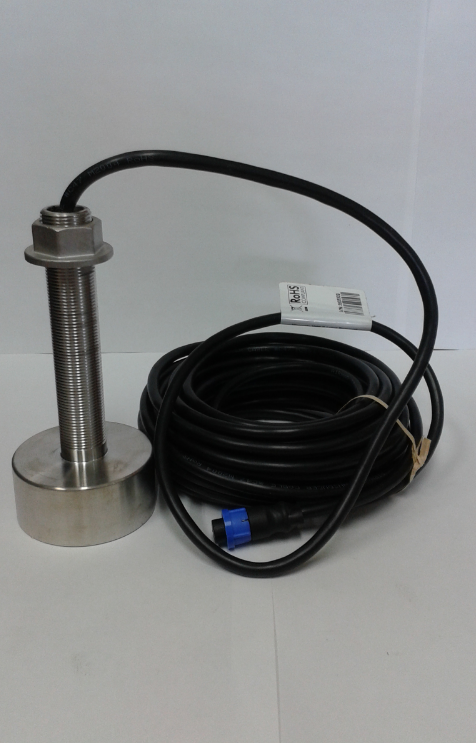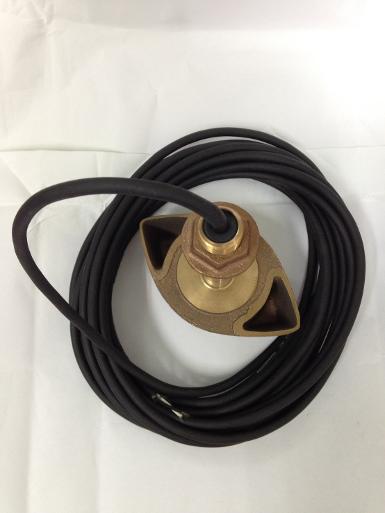
091-5758564, 081-6679233 ,02 7035192
OWNER’S GUIDE & INSTALLATION INSTRUCTIONS
Thru-Hull with Stem & No Fairing
Depth Transducer
Follow the precaution below for optimal product performance and to reduce the risk of property damage, personal injury, and/ or death.
WARNING: Always wear safety goggles and a dust mask when installing.
WARNING: Immediately check for leaks when the boat is place in the water. Do not leave the boat unchecked for more than three hours. Even a small leak may allow considerable water to accumulate.
CUATION: Always operate the transducer in water. Operating in air will allow the transducer to overheat possibly resulting in failure.
CUATION: The stainless steel housing must be isolated from a metal hull to prevent electrolytic corrosion. Use the isolation sleeve and washers supplied.
CUATION: SS422 The transducer must be oriented properly. The mark on the face must be forward and parallel to the centerline of the boat.
CUATION: Never pull, carry, or hold the transducer by the cable to the may internal connections.
CUATION: Never strike the transducer.
CUATION: Never use solvents. Cleaner, fuel, sealant, paint, and other products may contain solvents that can damage plastic parts, especially the transducer’s face.
IMPORTANT: Read the instructions completely before proceeding with the installation. These instructions supersede any other instructions In your instrument manual if they differ.
Tool & Materials
Safety goggles
Dust mask
Permanent marker
Electric drill
Drill bits and hole saws:
Pilot hole 3 mm or 1/8”
SS200 , SS502 23 mm or 15/16”
SS422 25 mm or 1”
Sandpaper
Mild household detergent or weak solvent (such as alcohol) File (installation in a metal hull)
Marine sealant (suitable for below waterline)
Knife or scissors (installation in a metal hull)
Slip – joint pliers
Grommet (s) (some installations)
Cable ties
Water - based anti - fouling paint (mandatory in salt water)
Installation in a cored fiberglass hull (see page 4):
Hole saws for hull interior: 35mm or 1-3/8”
Cylinder, wax, tape, and casting epoxy
Mounting Location
Guidelines
CUATION: Do not mount in line with or near water intake or discharge opening or behind strakes, struts, fittings, or hull irregularities that will disturb the water flow.
CUATION: Do not mount the sensor where the boat may be supported during trailering, launching, hauling, or storage to avoid damaging the transducer’s face.
- The water flowing under the hull must be smooth with a minimum of bubbles and turbulence (especially at high speeds).
- The transducer must be continuously immersed in water.
- The transducer beam must be unobstructed by the keel or propeller shaft (s).
- Choose a location away from interference caused by power and radiation sources such as: the propeller (s) and shaft (s), machinery , other echo sounders, and other cables, The lower the noise level, the higher the echo sounder gain setting that can be used.
- Choose a location with a minimal dead rise angle.
- Choose an accessible spot inside the vessel with adequate space foe the height to the stem and tightening the nut.
Installation
Hole Drilling
Cored fiberglass hull – Follow separate instructions on page4.
1. Drill a 3 mm or 1/8” pilot perpendicular to the waterline from inside the hull (see Figure 3). If there is a rib, strut, or other hull irregularity near the selected mounting location, drill from the outside.
2. Using the appropriate size drill bit or hole saw, cut a hole from outside the hull. Be sure to hold the drill plump, so the hole will be perpendicular to the water surface.
3. Sand can clean the area around the hole, inside and outside, to ensure the marine sealant will adhere properly to the hull. If there is any petroleum residue inside the hull, remove it with either a mild household detergent or a weak solvent (alcohol) before sanding.
Metal hull - Remove all burrs with a file and sandpaper.
CUATION: Be sure all surfaces to be bedded are clean and dry.
1. Remove the hull nut (see Figure3).
2. Apply a 2 mm (1/16”) thick layer of marine sealant surface of the transducer that will contact the hull / washer and up to the stem. The sealant must extend 6mm (1/4”) higher than the combined thickness of the washer, the hull, the second washer, and the hull nut. This will ensure there is marine sealant in the threads to seal the hull and hold the hull nut securely in place.
Metal hull – The stainless steel housing must be isolated from the metal hull to prevent electrolytic corrosion. Use the isolation sleeve and washers to separate the transducer stem from the hull. However, the top if the isolation sleeve must be below the hull nut after it is screwed into place, to prevent the sleeve from interfering with tightening the nut. Slide the isolation sleeve over the bedded transducer stem as far down as possible. Trim the isolation sleeve to length. Apply a 2mm (1/16”) thick layer of the marine sealant to the outside of the isolation sleeve.
Installing
1. Slide a washer onto the cable and stem of the transducer. Rest the washer against the transducer (see Figure3).
2. From outside the hull, thread the cable through the mounting hole. Then push the stem of the transducer through the hole using a twisting motion to squeeze put excess sealant.
SS422 – Orient the transducer, so the mark on the face and the corresponding mark on the stem are forward and parallel to the centerline of the boat (see Figure2).
3. From inside the hull, slide the second washer and the hull nut onto the cable. Rest the washer against the hull. Screw the hull nut in place against the washer. Tighten the hull nut with slip-joint pliers.
SS422 - Be careful not to rotate the housing disturbing the aliment. When grasping the stem, be careful not to damage the threads.
Metal hull – Be sure the isolation sleeve is between the transducer stem and the hull. However, the top of the isolation sleeve must be below the hull nut to prevent the sleeve from interfering with tightening the hull nut.
|














 สินค้าที่เกี่ยวข้อง
สินค้าที่เกี่ยวข้อง
